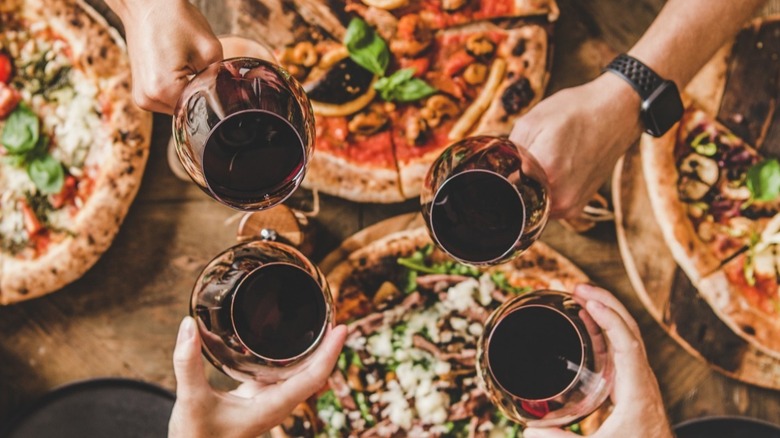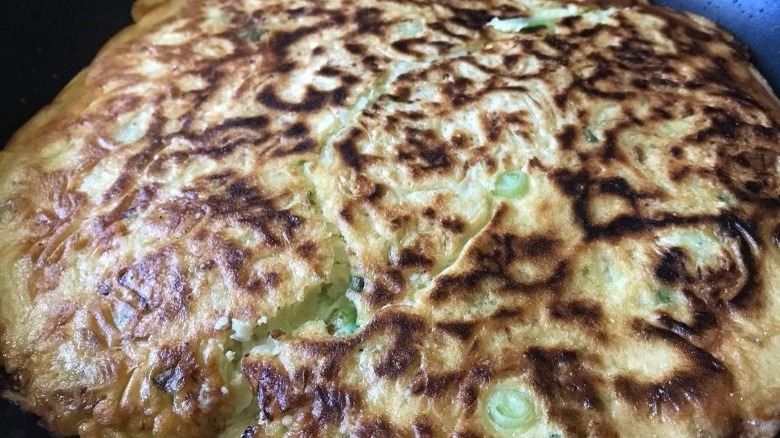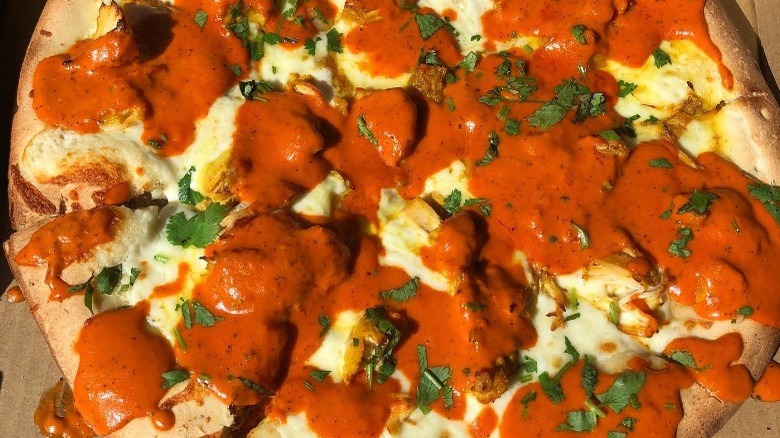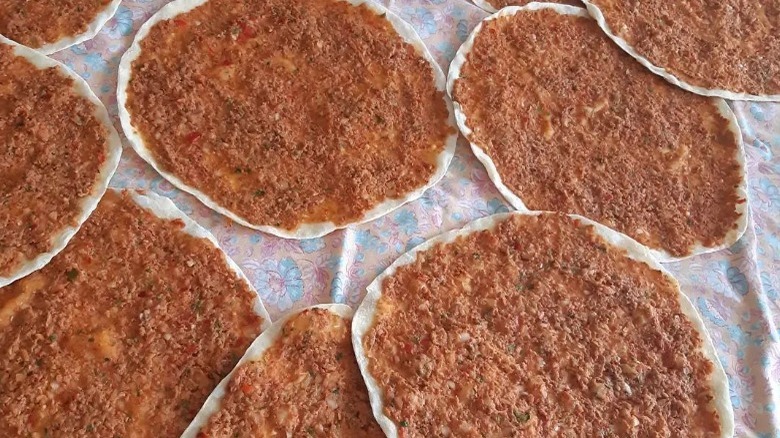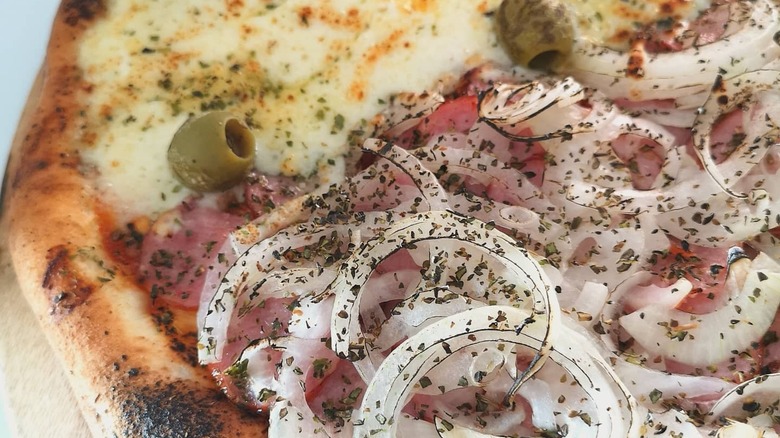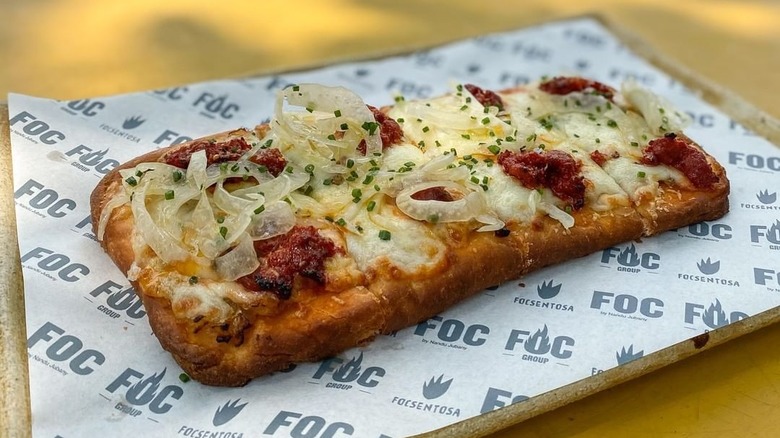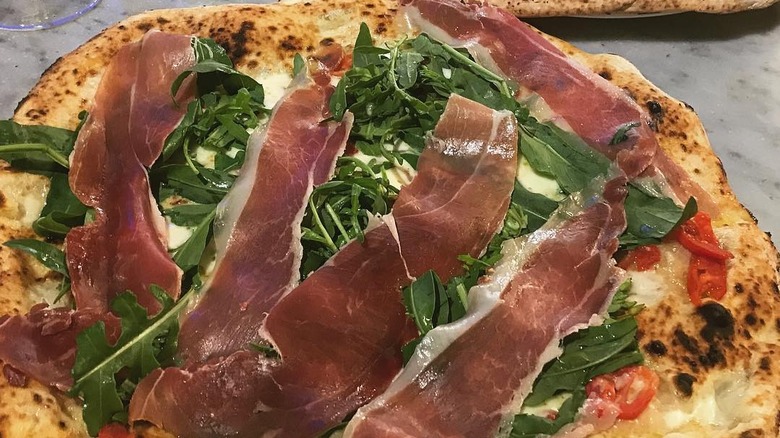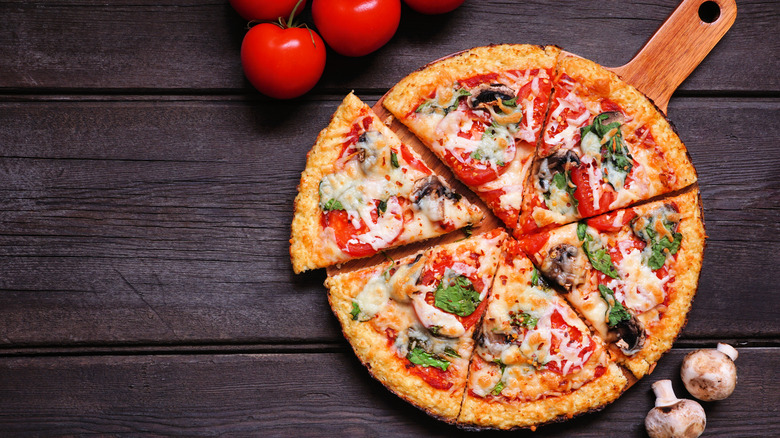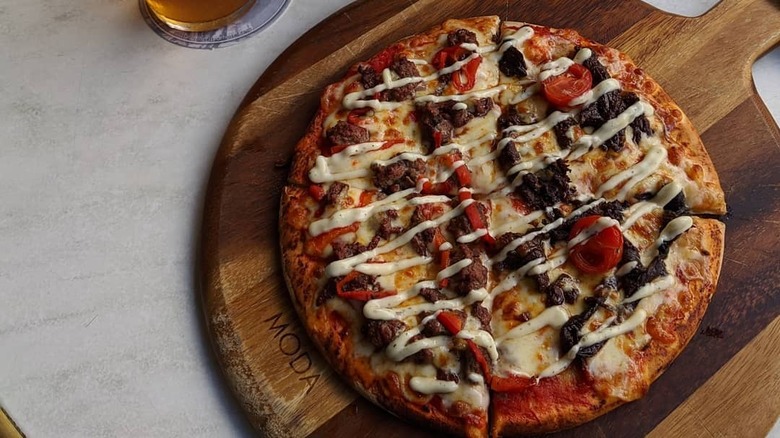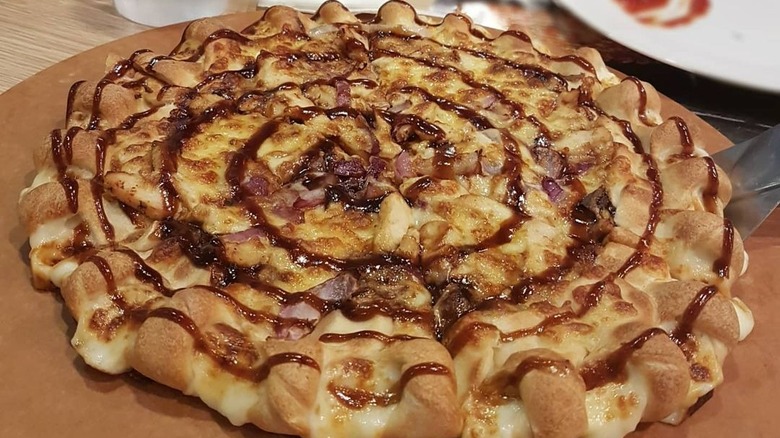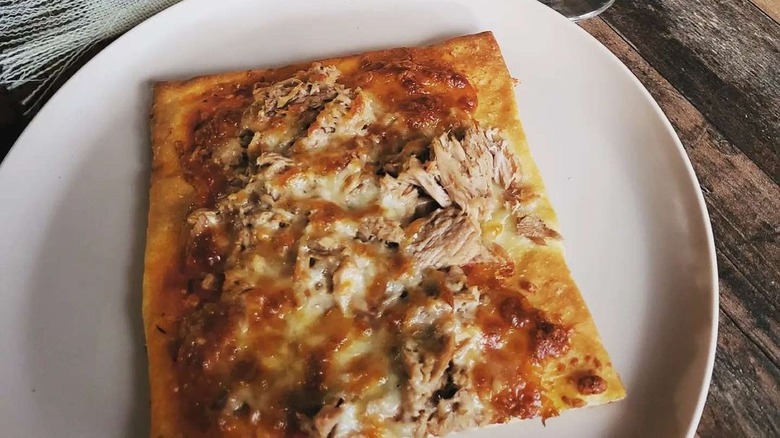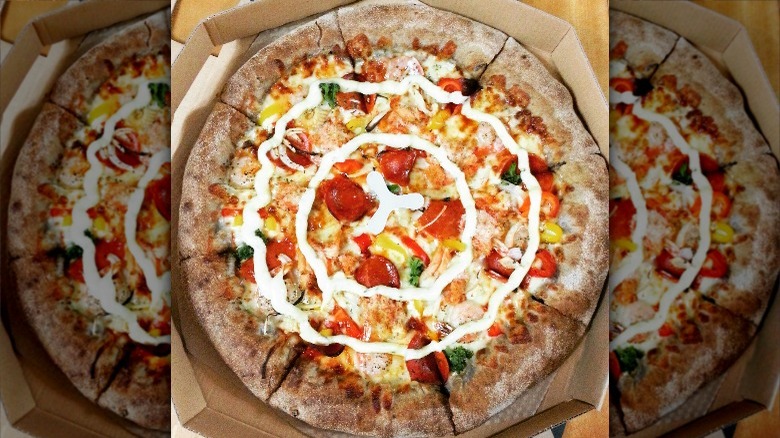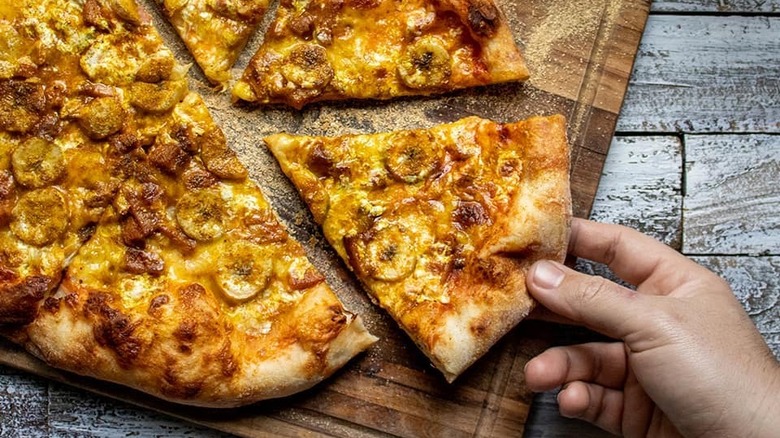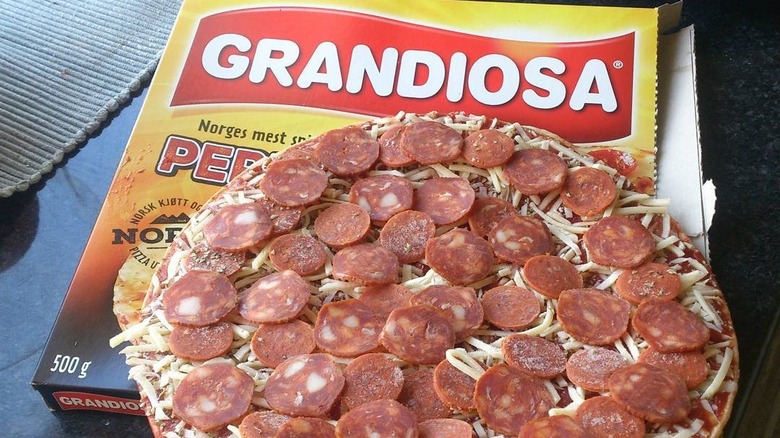How People Really Eat Pizza Around The World
As much as Americans love it, we must admit that the United States might not be the birthplace of pizza, according to History. But, rest assured that the nation has birthed a number of unique and internationally known pizza styles.
From Chicago's decadent deep dish to New York's paper-thin oversized slice, a number of American cities can rightfully ay claim to their own unique take on pizza pies. Even lesser-known regional varieties like St. Louis' cracker crust style or Philadelphia's sheet pan creation have dedicated followings.
But while these combinations might be unique, the U.S. isn't the only place in the world to have its own pizza style. Nearly every country across the globe has a topping combination or crust style that it's known for. From seafood-covered pies in Japan and South Korea to cheese-less varieties in Turkey and Spain, there is a unique and tasty pizza style to try in every corner of the globe. Keep reading to find out how people really eat pizza around the world.
Seafood is the topping of choice in Japan
In the U.S., pepperoni is the most popular pizza topping, while anchovies are the least. Americans travelers to Japan, then, could be shocked to find that seafood of all types is commonplace on pies. While nearby China might lead the world in seafood consumption, Japan might be in the running for consuming seafood-topped pizzas.
Per Tsunagu Japan, fish eggs, squid, pickled mackerel, and sakura ebi, a type of tiny dried shrimp, are all popular options. Meanwhile, squid ink pizza features black squid ink mixed with tomato sauce, and topped with squid, as well as other toppings like onions or tomatoes (via Gurunavi). Besides seafood, another popular pizza topping is made from fermented soybeans, also known as natto.
Okonomiyaki, which translates to "grilled the way you want it" is a pancake-style treat that's also often referred to as Japanese pizza, says Takeaway.com. Okonomiyaki's batter is mixed with strips of cabbage and other veggies, then topped with a special okonomiyaki sauce or Japanese mayonnaise (Kewpie, anyone?). From there, as the name suggests, diners choose other ingredients to add in. It's often made at home, though many restaurants now offer okonomiyaki as well. Some even bring a grill plate to your table with your options for ingredients so that you can make it yourself.
Try tandoori chicken on pizza in India
With Domino's, Pizza Hut, and Papa John's topping the list of popular pizza restaurants in India, it's no surprise that your pie options are very similar to what you'll find in the U.S. However, there are plenty of exceptions to this rule.
To start, the Seattle Times reports that some Indian restaurants in the U.S. are now offering pizzas with distinctly Indian flavors. These are often distinguished by their unique toppings like cauliflower, ginger, and garlic, to pies graced with other Indian dishes, like tandoori chicken or chicken tikka masala.
Even chains have hopped on the Indian pizza train. Domino's in India, for instance, offers an Indi Chicken Tikka pizza. This pie is topped with tandoori masala and chicken tikka, onions, and red paprika, with a squeeze of mint mayonnaise on top.
If you love naan, you might be expecting thin-crust pizza to be the popular choice in India. However, the Seattle Times notes that most restaurants use something a bit thicker in order to hold up to the rather heavy, wet ingredients and sauces.
Pide wins out over pizza in Turkey
Order a Turkish pizza while in Turkey, and you might be surprised to be served something that more closely resembles a flatbread. Also called lahmacun, which translates to "meat and dough," (via American Heritage Dictionary), so-called "Turkish pizza" is just that. An ultra-thin, crispy crust is spread with minced meat cooked with peppers and tomatoes, as well as a mix of herbs and spices.
A variation of Turkish pizza, called pide, is easy to spot thanks to its boat-like shape. Per The Guardian, the dough used to make pide is slightly thicker, and is folded slightly at the edges to trap the pile of meat and cheese within. The type of meat used varies, though lamb is a popular choice. Pide is often cooked in wood-fired ovens, giving the crust a smoky, crispy finish.
According to World Food Story, this traditional dish was possibly created under the more far-ranging Ottoman Empire, so you'll also find variations on lahmacun and pide in Lebanon, Armenia, and quite a few other countries.
Don't be surprised to find traditional Italian pizza in Brazil
When most people think of traditional Brazilian cuisine, they think of barbecued meats, hearty stews, or even tasty pão de queijo, a kind of cheese bread. But head to São Paulo, and you'll find that tradition and pizza go hand in hand.
Brazil experienced a wave of immigrants from Italy during the 20th century. Many settled in São Paulo, which is now home to the largest Italian community in Latin America, according to Reuters. Their influence can be easily seen in the local food culture. The very first pizza parlor in the city was opened in 1924, per The Guardian. Today, there are more than 6,000 pizza parlors across the city, serving nearly a million pizza pies each day.
According to The Culture Trip, São Paulo's pizza parlors combine traditional Italian pizza styles with unique Brazilian toppings. This means puffed crusts and perfectly spiced tomato sauce topped with vibrant meats and creamy cheese. One popular Brazilian pizza style brócolis features mozzarella cheese, broccoli, slices of bacon, cream cheese, and oregano, reports The Brazil Business. Another, frango com catupiry, comes with shredded chicken, cream cheese, and oregano with classic tomato sauce.
Cheese-less pizza is common in Spain
While you'll find plenty of American pizza chains in Spain's larger cities, in most parts of the country, ordering a pizza means digging into something known as coca.
According to the Los Angeles Times, coca is a flatbread dish that usually doesn't have cheese or sauce. Instead, it's topped with other savory ingredients like olive oil, onions, peppers, tomatoes, and meats like ham and bacon, all served on a rectangular crust. The flatbreads are baked on pizza stones and in ovens that can achieve the high temperatures necessary to get those perfect, crispy edges. For that reason, coca pizzas usually aren't frozen or even prepared from scratch at home.
But coca isn't just a meal. It can also be a sweet dessert. Ingredients like sugar, pine nuts, and citrus fruits are popular toppings on sweet coca. The sugar is baked to a glassy, crunchy finish similar to the topping on a creme brûlée. For sweet cocques (the plural for coca, by the way), lard is added to the crust to achieve a more flaky finish. While the result is delicious, we must admit that vegetarians and vegans may want to avoid this dish, given the animal-derived lard.
Italy is the first home of pizza
Naples, Italy is the undisputed home of pizza. As many decadent foods enjoyed today once were, early pizzas were actually considered foods reserved for the city's poor, as the pies were easy to eat quickly and were typically topped with cheap ingredients. Though pizza's enjoyed growing popularity and even a royal thumbs-up from Italy's Queen Margherita, it didn't spread to the rest of the country until the 1940s. Moreover, this was only after pizza became popular in the U.S., where immigrants from Naples had begun replicating their pies and selling them in cities like New York, Chicago, and St. Louis.
Pizza has come a long way from these early origins, even in its homeland. Today, Italy's pizzas don't look that much like the "Italian" pizzas you'll find in most places in the U.S. To start, in Italy, pizza is rarely served by the slice. Pies are often meant to be personal-sized, though it's common for diners to each order a different kind of pizza and then swap slices with their companions.
Visitors to an Italian pizzeria might be surprised to find that shredded mozzarella cheese is not a given, says The Travel. However, fresh ingredients, like slices of eggplant and prosciutto or creamy burrata cheese, definitely are. Crusts are still thin and baked until crisp, much like the original varieties that arose in the 19th century.
Many Russians prefer their pizza cold
Every country has a popular food that locals love and tourists tend to scoff at. Russia no doubt has a number of such foods — borscht, a stew made with beets, and shchi, a soup made from fermented cabbage, are a couple that comes to mind. But order a pizza in Moscow, or anywhere in Russia, for that matter, and you might be shocked when your dish arrives cold and covered in fish.
Mockba is a popular style of pizza throughout Russia, reports the Times of India. Named after Russia's capital, this style is served cold and topped with a combination of fish, such as mackerel, sardines, tuna, salmon, and vegetables like onion.
Craving something a little less fishy or maybe a warm slice? Don't fret, as there are plenty of chains serving more American-influenced styles of pizza, like Papa John's, which opened its 100th restaurant in the country in 2017. Meanwhile, delivery chain Dodo Pizza has made waves in Russia and beyond. Founded in 2011, it has since spread to over a dozen other countries. Alongside some interesting Dodo Pizza offerings like cheeseburger pie, you can order a pizza shaped like a cartoon bear's head.
Double Dutch pizzas in the Netherlands
Compared to other countries on this list, the pizza toppings enjoyed by locals in the Netherlands are far from wild. However, the nation does have its own unique pie style aptly named the Double Dutch.
A Double Dutch pizza starts with frozen pizza dough that's then layered with double portions of cheese and then piled with onions and beef. Because the double helping of heavy ingredients weighs this pie down, the crust is usually pretty thick, says DeIorio's. Technically speaking, a Double Dutch pizza could feature double portions of any toppings, though beef and onions are the most popular.
Plant-based diners don't need to fret, however. In 2018, LiveKindly reports that Netherlands pizza chain New York Pizza released two unique vegan pizzas. Donations from the sale of the two pies went to the Sea Shepherd Conservation Society. The two pies were the Sea Shepherd Vegan Veggie, which featured tomatoes, arugula, and vegan cheese, and the Sea Shepherd Vegan Shawarma Pizza, which featured vegan meat, garlic, vegan cheese, and red onion. The two menu items were the first fully vegan offerings from the chain.
Australian pizza may be topped with kangaroo
Most pizza joints in Australia serve up classic pies that would be right at home in America, Italy, or elsewhere in the world. Cheese and pepperoni are amongst the most popular toppings Down Under, while the pineapple-heavy Hawaiian pizza is seemingly less controversial there than it is in the U.S.
But some pizza restaurants across the country like to give their pies a uniquely Aussie twist. At the Australian Heritage Hotel in Sydney, for instance, you can order the Coat of Arms Pizza with half of the pie coming with grilled kangaroo steak and the other half graced with marinated emu mixed with tomatoes (via FoodBeast). The entire pie is drizzled with lemon myrtle mayonnaise.
Yet, this hotel may still be unique even in Australia for serving up kangaroo. This meat may be gaining speed in the country, but it's still pretty rare on restaurant menus nationwide.
The United Arab Emirates puts a unique spin on pizza
The United Arab Emirates is known for being a hub of foods and flavors from around the world. But you'll still find plenty of traditional Emirati cuisine like fattesh and rigag, an Emirati crepe.
When it comes to pizza, the UAE's international influence continues, often with a pretty wonderful twist. For instance, the UAE's Pizza Hut released a Cone Crust Pizza in 2012, per Brand Eating. This pie featured a crust that was folded at intervals around the edges, creating baked cones that were filled with cream cheese, honey mustard chicken, or a combination of the two.
Other popular pizza pie toppings reflect more traditional Arab flavors. Pizza Hut offers a pie topped with chicken shawarma, for instance. And if you order a Hawaiian pizza in the nation, and you can expect to receive roasted turkey in place of ham. And if Pizza Hut isn't quite your style while in the UAE, you'll find a wide variety of international chains, like Little Caesars, Domino's, Pezzo, and more.
Try canned tuna pizza in Germany
In a survey of the most popular pizza toppings in Germany by HelloFresh (via True Italian), salami and Hawaiian style-pizzas topped the list. If you thought that the popularity of the divisive pineapple and ham pizza was surprising, you can think again. The third-place winner was none other than tuna. And not just any tuna. In Germany, it seems that only canned tuna will do.
Pizza topped with tuna even has its own unique name in the country, where it's called "Thunfisch pizza." If you thought that anchovies on pizzas made for some strong smells, just wait until you get a whiff of a Thunfisch pizza. Still, you may want to give it a try and see for yourself.
Looking for pizza better suited for date night, that won't leave your breath smelling fishy? Don't worry, because Big 7 reports that Germany has a strong artisanal pizza scene that offers plenty of other options.
South Koreans prefer seafood on their pies
Much like Japan, South Korea isn't afraid to get creative with its pizza toppings, including seafood. You'll even find a Cheesecake Black Tiger Shrimp Pizza on the menu at Domino's, according to Stars and Stripes Korea. This pizza starts with a comparatively normal crust that looks like what you might get at your corner Domino's franchise in the U.S.
The pie's parmesan and mozzarella cheese, as well as sun-dried tomatoes and bacon chips, are also fairly tame to American palates. But from there, things get pretty unique, at least from an American perspective. Creamy cheesecake mousse, black tiger shrimp, and horseradish sauce finish off this uniquely South Korean pie.
All told, Domino's is pretty well known in South Korea for its culturally inspired pizzas. But local chains and restaurants combine Korean ingredients with traditional Italian pizzas, too. For instance, gochujang and bulgogi can be had on some pizzas there, according to Roads & Kingdoms.
Try banana curry pizza in Sweden
In the U.S., Italy, and within the confines of Gordon Ramsay's kitchens, the most divisive fruit-based pizza topping is surely pineapple. But in Sweden, a different fruit is added to their savory pies and Swedish people don't appear to be divided on it at all.
You'd be hard-pressed to find bananas on the menu of a pizza restaurant in the states. But in Sweden, it's seriously a popular topping choice, says Snopes. One combination, in particular, tends to turn the heads of tourists: banana curry pizza. According to Culture Trip, this dish starts with the ultra-thin crust that's popular across the nation. Tomato sauce comes next, then a scattering of smoked, grated cheese. Two bananas are sliced thin and spread on the pizza, then sprinkled with curry powder.
It turns out that bananas are a popular ingredient in many Swedish foods, including drinks and desserts. This fruit is so often consumed in the nation that today, Sweden often ranks pretty high in European banana consumption, per the Helgi Library.
Norway consumes a ton of pizza
If you think that Italy or the U.S. leads the charge in pizza consumption per capita, think again. Instead, this honor belongs to Norway. Not only does Norway consume more pizza per capita than any other nation in the world, but it also consumes mainly frozen pizzas, with a single brand Grandiosa, accounting for around half of all frozen pizza sales.
Norway's history with frozen pizza isn't as long as you'd think. Up until the end of the 1970s, pizza was largely unheard of in the Nordic nation. Per The Daily Meal, the legend goes that a company called Stabburet needed to produce new products. Factory managers didn't know what a frozen pizza was but agreed to make some anyway. The result was Grandiosa. The frozen pizza brand launched in February of 1980, and the rest, as they say, is history. Today, many Norwegians consider Grandiosa pizza their unofficial national dish.
Today, you'll find Grandiosa pizzas in pretty much every Norwegian grocery store. The Grandiosa Original features a tomato sauce base topped with ham, Jarlsberg cheese, and paprika. According to The Daily Meal, over 9 million of these pies are sold every year, with Norwegians consuming some 47 million frozen pizzas annually.
